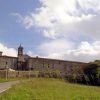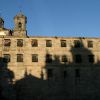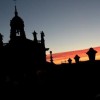- Accede I
- Regístrate I
- carrito
Convento de clausura de Santa María de Belvís
Fundación: S. XIV. Estilo actual: Barroco.
El convento de clausura de Belvís, fundado a principios del s. XIV por los frailes dominicos del vecino convento de Bonaval, es el primer convento femenino que tuvo la orden en Galicia. Tiene la peculiaridad de poseer dos templos: la iglesia conventual y el santuario de la popular Virgen del Portal.
Se encuentra algo alejado del conjunto histórico, en un promontorio al que se llega por la singular Rúa das Trompas, atravesando el parque de Belvís, una especie de foso natural que lo separa de la ciudad histórica. A su lado, otra de las principales instituciones religiosas de la ciudad, el Seminario Menor (en su interior se aloja un albergue de peregrinos).
En el pasado la mayoría de sus monjas eran hijas de burgueses, a lo que se atribuye la lentitud de las obras y la sobriedad del convento (las hijas de nobles aportaban una dote mayor).
A principios del s. XVIII se reedificó el edificio conventual. En la sencilla fachada resalta el escudo del arzobispo Monroy, mecenas de la construcción, y la torre, que sirve de unión entre la iglesia conventual y la capilla de la Virgen del Portal (1702), dispuestas en ángulo recto.
La iglesia conventual
La iglesia, sólo visible durante el culto de los domingos, está destinada a la oración íntima de las monjas. Es una obra de la primera mitad del s. XVIII de Casas y Novoa, el mismo arquitecto de la fachada de la Catedral. El conjunto es de gran sencillez y sobriedad. Lo más destacado es la fachada del comulgatorio (ventanilla por la reciben las dominicas la comunión) en la que el arquitecto utilizó su característica decoración geométrico-vegetal.
La capilla de la Virgen del Portal
Es una sencilla capilla en la que destaca la talla de la Virgen del Portal, gótica del s. XIII. A la Virgen la acompañan dos estatuillas, que probablemente representan al pueblo cristiano. Sobre el camarín de la Virgen está la imagen de Santo Domingo de Guzmán, fundador de la orden. A la izquierda San José, y a la derecha el dominnico San Martín de Porres, más conocido como “Fray Escoba”. La devoción a la Virgen del Portal está muy arraigada en Santiago. Su nombre viene de una imagen que apareció durante las obras de fundación del convento en el siglo XIV y que fue colocada inicialmente en la portería. En el s. XVII las monjas quisieron trasladarla en varias ocasiones a la iglesia, pero la imagen misteriosamente volvía a la portería, por lo que se decidió hacer allí un pequeño santuario. La Virgen comenzó a hacer milagros y su fama se fue extendiendo. Es invocada para todo tipo de enfermedades y también para el éxito en los exámenes. Su festividad se celebra el 8 de septiembre con una romería muy concurrida a la que algunos devotos acuden sacrificadamente de rodillas o descalzos. Otros ritos para solicitar el favor de esta Virgen son la ofrenda de velas, la solicitud del manto de la virgen para colocarlo sobre los enfermos y el agua bendita del santuario.
Las dominicas de Santiago
En el convento de Belvís viven actualmente 30 madres. Como trabajo diario, además del doméstico, el cuidado de la huerta y el ensayo del canto, las dominicas realizan bordados para las iglesias y para particulares y también obleas para las misas de la ciudad. Pero son sobre todo famosas por sus deliciosos postres, que hacen por encargo (almendrados, mantecados, tarta de Santiago) o venden al momento (pastas de té, recortes de oblea) en horario de torno.

















